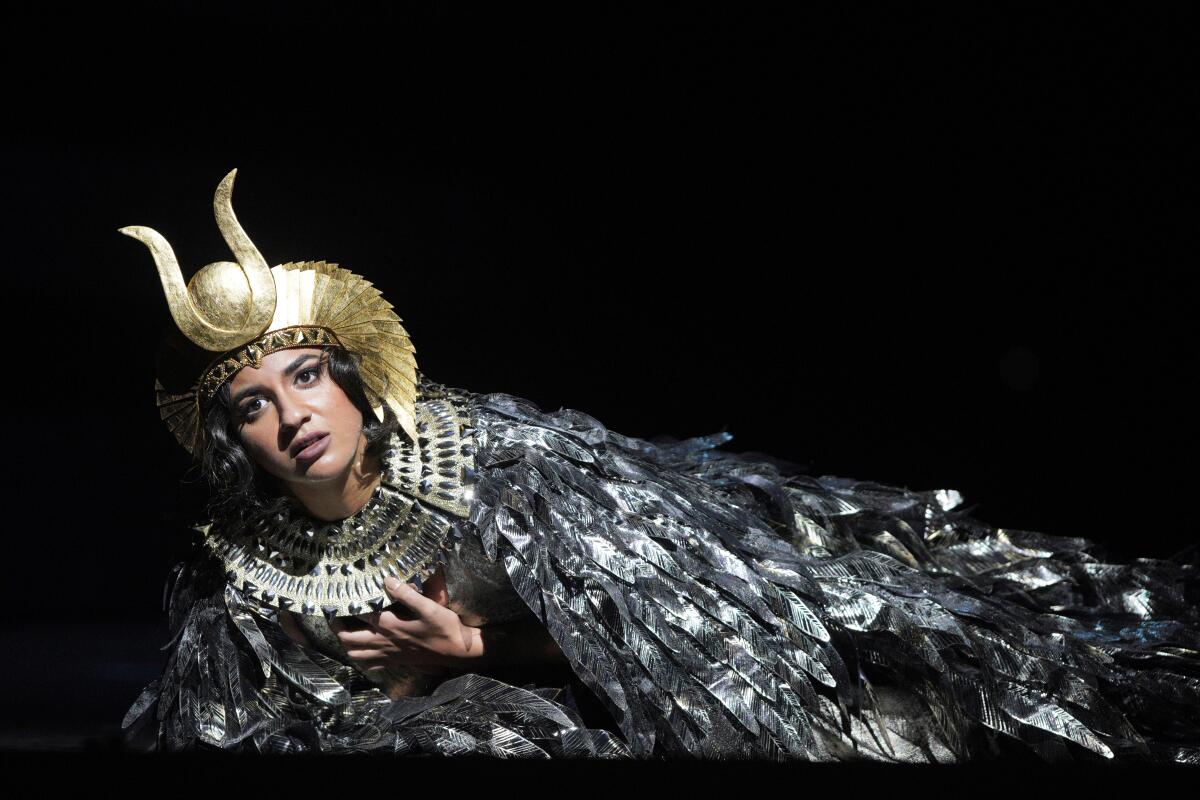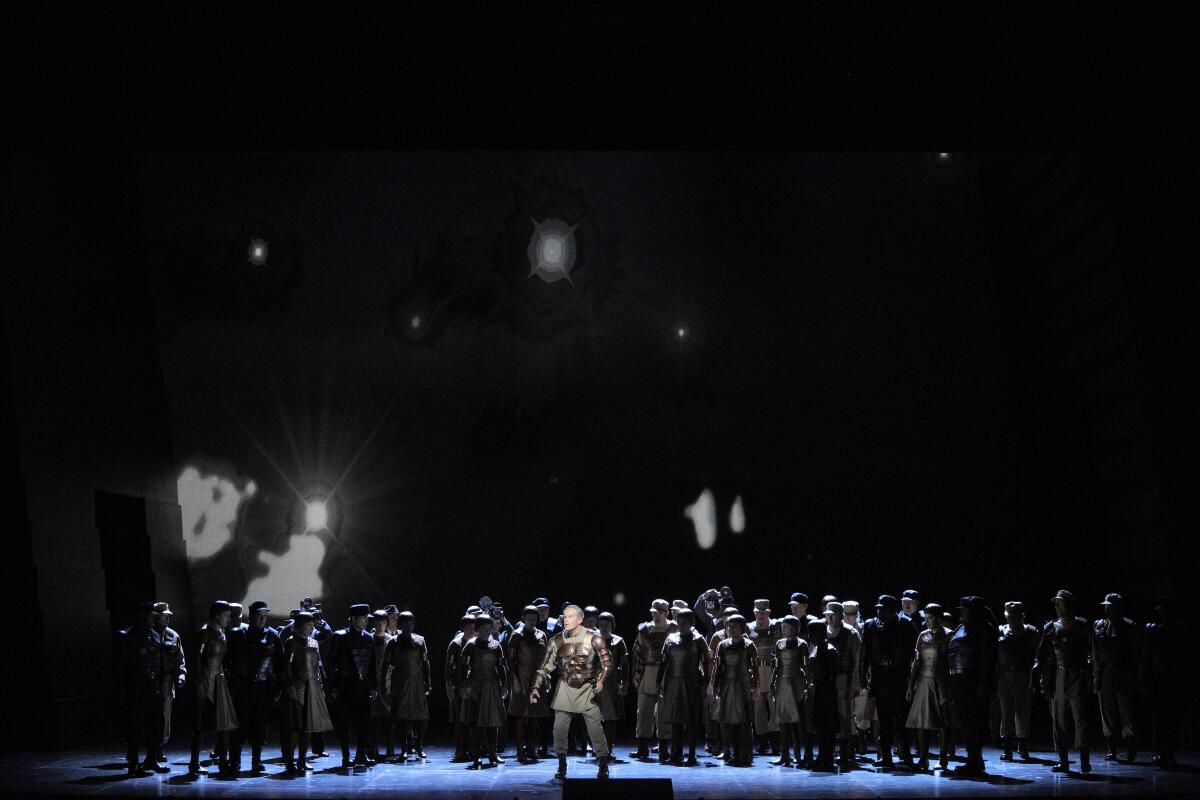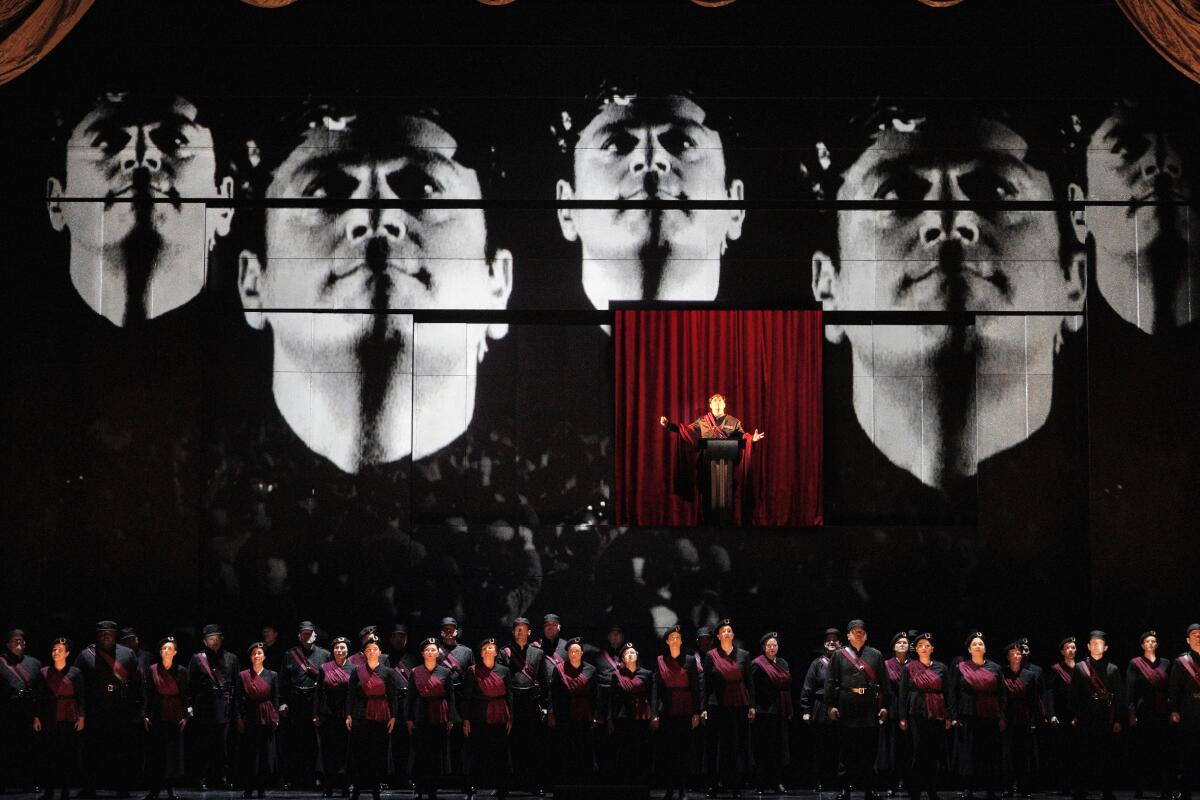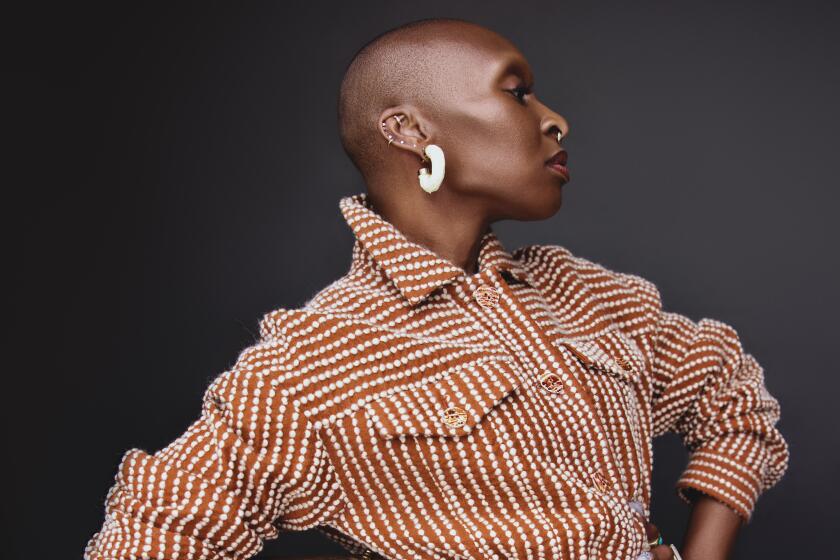Review: In John Adams’ new ‘Antony and Cleopatra’ opera, the orchestra is the star

- Share via
San Francisco — Thirty-five years ago, John Adams’ first opera, which changed the way opera would be made and matter in America, had its first public workshop performance in a small theater, the Herbst, next door to San Francisco Opera’s War Memorial Opera House. It was a concert reading of “Nixon in China,” with the singers and piano accompaniment.
In the audience was the then-head of San Francisco Opera, Terence McEwen, who slept through the first two scenes and ostentatiously walked out before the end of the first act. He was said to have proclaimed that his company would only perform “Nixon” over his dead body. It eventually did. And a lot more once McEwen had retired.
Saturday night, San Francisco Opera, America’s second-oldest opera company after the Metropolitan in New York, began its second century with the world premiere of Adams’ fifth opera, “Antony and Cleopatra,” thus cementing the most significant relationship between any opera company and composer in the last century. San Francisco Opera has now commissioned or co-commissioned four of Adams’ five major operas and given the world premiere of the last three.
With “Nixon,” “The Death of Klinghoffer,” “Doctor Atomic” and “Girls of the Golden West,” Adams and his close and crucial collaborator, director Peter Sellars, revealed the mythic dimension of recent history in the first three and of the gold rush in “Girls.” “Nixon” (which finally reached San Francisco in 2012, 14 years after McEwen’s death) looked at how the perceived differences of East and West perpetrated the Cold War. Meanwhile, “Klinghoffer” continues to prove shocking in its explication of the roots of terrorism. Both operas boast Alice Goodman libretti that promise to become lasting works of literature.
“Doctor Atomic” exposes the human side of the making of the atomic bomb; “Girls” uncovers the surprising foundational roots of the exploitative capitalism that has ultimately given rise to the careless excesses of Silicon Valley. Those libretti are striking assemblages from documentary and literary sources by Sellars that Adams’ music brings to life. In his operas, while ever full of spectacle, history and myth are made personal.
“Antony and Cleopatra,” though, is different. For the first time, Adams has attempted music theater without Sellars, electing instead to work with the young director Elkhanah Pulitzer (who staged a highly praised “Nixon” that Adams conducted with the L.A. Phil in 2017) and dramaturg Lucia Scheckner.
For whatever reason, it is difficult to escape the symbolism of Adams now turning to the very play and place that brought Sellars to public notice. While an undergraduate in 1978, Sellars staged Shakespeare’s “Antony and Cleopatra” in the swimming pool of Harvard’s Adams House. The Harvard Crimson described it as “scene after scene of slapstick splashing and general mayhem.” Ernest Fleischmann, the former head of the L.A. Phil, saw it and decided then and there that Sellars would one day have a role with the orchestra. In 1992, Sellars was hired as the first orchestra dramaturg anywhere.

There is no mayhem in Adams’ “Antony.” The composer himself fashioned a straightforward libretto from Shakespeare’s text in consultation with Pulitzer and Scheckner. There is necessary paring down of this vast saga, limiting the number of characters. The focus is on Antony and Cleopatra as mature lovers. A bit like Adams’ Nixon and Mao, they are uncertain aging rulers putting up a good front as they try to keep their realms viable in a changing world that no longer has use for them — but will never, as we are once more reminded, forget their tragedy.
The opera unfolds in two long acts (80 and 85 minutes, respectively). Shakespeare offers little room for arias, although Adams borrows from Dryden’s translations of Virgil’s “Aeneid” to give one to Caesar, who stands for the force of modernity in his empire building. Adams has likened that in his program note to the way Silicon Valley masters of the universe operate.
The result, though, on first hearing can sound like an endless flow of parlando singing, more ongoing narration than operatic musing, music confined to underscoring Shakespeare’s unbroachable phrases. Pulitzer’s cautiously fluid production and Mimi Lien’s tasteful, architectural sets offer no innovation. The costumes by Constance Hoffman and video projections riff on the glitz, but not the sexiness, of Cecil B. DeMille’s 1934 “Cleopatra.”
The point of Claudette Colbert as a Hollywood ideal of the Egyptian queen, however, is lost in narrative ordinariness. Even the opening duet between the lovers falls flat with surprisingly little show of passion.
The singers are very good, but characters fail to come to life. Much of this may have to do with the direction. Gerald Finley proved a complexly fascinating J. Robert Oppenheimer in “Doctor Atomic.” In the love duet that opens the new opera, for which Adams borrowed a few lively lines from “The Taming of the Shrew,” Finley’s Mark Antony is without heat. But he stews magnificently, growing old ungracefully, the former hero tragically unable to let go of his ego.
Bullock was Adams’ muse for this Cleopatra but, about to give birth, she has had to bow out of the San Francisco performances. She will join the production when it travels to Barcelona and the Met over the next couple of years.
Fortunately the soprano Amina Edris, who happens to be Egyptian, brings effective sparkle to her Cleopatra. At her most extravagant, the queen delivers the kind of glorious vocal fireworks that celebrated the over-the-top qualities of Madame Mao in “Nixon.” In this Edris shines. But Adams’ portrayal of Cleopatra is far richer, and Edris, who sings the rhythmically intricate Shakespeare settings with more attention to accuracy than dramatic inflection, will need time to fully internalize a long, difficult part. Tenor Paul Appleby, another Adams veteran (“Girls”), is a Caesar disconcerting in his confidence, showing a calculating vibrancy that becomes the face of fascism.

As with all of Adams’ music theater, singers are amplified, and the amplification has constantly improved with new equipment. With his usual sound designer, Mark Grey, voices ring true and blend beautifully with the orchestra.
But it is in the orchestra where the magnificence of the opera lies. Ever churning, ever changing, ever exploring nuance, the orchestra reveals much about the characters in the opera — their inner essence and, to great extent, their outer aspects. It is the tuba, for instance, that lets us feel the power of Caesar. Instrument after instrument gets its theatrical moment.
Adams does have his amusing moments. A composer who often contextualizes with music from the past in unexpected ways, he riffs on the famous watery opening of “Das Rheingold,” conflating Cleopatra’s Nile to Wagner’s Rhine. But the tone of “Antony” remains soberly serious throughout, missing the startling moments of humor and whimsy that often found a way into his collaborations with Sellars. The use of chorus is typically marvelous but limited.
This essentially leaves the drama to San Francisco Opera’s music director, Eun Sun Kim, who conducts with impressively relentless enthusiasm and becomes a central figure. If you can’t get the complicated rhythm right, Adams’ music falls apart. She gets it right, but, not unlike Edris, without yet a sense of spontaneity.
Is Adams’ “Antony and Cleopatra” a disappointment? The theatricality is, as staged, pedestrian. The conformity to Shakespeare leaves little room for surprising revelation. This is an “Antony” that is no Sellars swim against the tide, no dip in the Nile.
But what it importantly demonstrates is late, mature Adams. There is nearly three hours’ worth of orchestral writing to delve into. For all its ordinariness in the opera house, the orchestra abounds. After a look at the score, its musical subtleties are waiting to be discovered and savored. Each of Adams’ operas, moreover, has gone through revisions. Second performances of “Doctor Atomic” and “Girls” only fully came alive when they reached the Dutch National Opera a year after their San Francisco premieres.
It is also important to remember that every one of Adams’ operas has had initially mixed — and in some cases hostile — first receptions. McEwen was hardly in the critical minority at that “Nixon” workshop, including in this newspaper.
More hearings are needed. And, to San Francisco Opera’s credit, more are on the way, and not just in the opera house, where it runs through Oct. 5. The Sept. 18 Sunday matinee will be livestreamed on the company’s website and made available for 48 hours. After more hearings, we can talk.
'Antony and Cleopatra'
Where: War Memorial Opera House, 301 Van Ness Ave., San Francisco
When: 2 p.m. Sunday (also livestreamed and archived for two days) and Oct. 2. 7:30 p.m. Sept. 23, 27 and Oct. 5.
Tickets: $25-$450, $27.50 to stream
Info: sfopera.com
Running time: 3 hours, 17 minutes
More to Read
The biggest entertainment stories
Get our big stories about Hollywood, film, television, music, arts, culture and more right in your inbox as soon as they publish.
You may occasionally receive promotional content from the Los Angeles Times.











